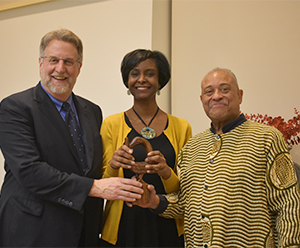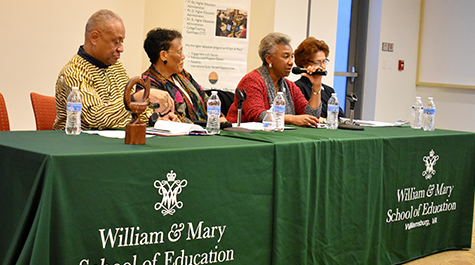Learning from the past to shape the future
“We can’t heal until we see that we’re wounded.” Emerita faculty member Brenda Toler Williams Ed.D. ’83 shared those words at the School of Education on March 15 during a panel of alumni and retired faculty who were among the first African-Americans to join William & Mary as students and faculty.
Held in conjunction with the university’s year-long commemoration of 50 years of African Americans in residence and the 2018 Lemon Project Symposium, the panel explored the personal and academic experiences of these trailblazers, as well as the larger context of equity and inclusion in higher education.
Joining Williams on the panel were two of the first three African-American students to live on campus, Janet Brown Strafer and Lynn Briley, both class of 1971. James M. Patton, the first African-American faculty member at the School of Education, was the fourth panelist. Stephanie Blackmon, assistant professor of higher education, moderated the panel and has served as chair of the 50th commemoration efforts for the School of Education.
“We’re so grateful to the panelists for sharing their time and their stories with the School of Education community,” said Spencer Niles, dean of the school. “The discussion was deeply moving, and exactly the kind of courageous conversation that we must continually engage in, as an institution and as individual educators.”
 The concept of Sankofa, the theme of the 50th commemoration, was present throughout the evening’s discussion. From the Akan language of West Africa, Sankofa reflects the idea that “it’s not taboo to go back and fetch what you forgot.”
The concept of Sankofa, the theme of the 50th commemoration, was present throughout the evening’s discussion. From the Akan language of West Africa, Sankofa reflects the idea that “it’s not taboo to go back and fetch what you forgot.”
“The goal of the panel was to honor these trailblazers, learn from their experiences, and use those experiences to shape and improve the future of the academy,” said Blackmon. “The panel experience was a time for listening and a call for doing.”
Patton, who retired in 2009 after a 22-year career at the School of Education, presented Blackmon, Niles and the school with a wooden figurine of a bird looking back while moving forward, an Adinkra symbol that represents the philosophy of Sankofa. Plans are underway to display the figurine in the atrium of the School of Education.
A life-changing choice
All four panelists grew up in the segregated South, attending all-black high schools. They were smart and motivated to achieve academically, but the support and expectations they encountered in their high schools varied. Briley, who grew up in Portsmouth, shared that she and her classmates were encouraged to apply to predominantly white universities. “The doors had already been knocked down, so we were encouraged to walk right through.” She was drawn to the idyllic setting of William & Mary, and its affordability was another attraction.
Strafer had the opposite experience. No one in her family had ever been to college and her guidance counselor discouraged her from applying to William & Mary, saying that she was unlikely to succeed and that Norfolk State, a historically black university, would be a better fit. “That made me angry,” said Strafer. “My tenacious spirit took over, and I had to prove that counselor wrong.”
Two decades after Briley, Strafer and their classmate Karen Ely arrived as the first residential students, Patton was invited to joined the faculty at the School of Education. Having already served on the faculty at Virginia State University, Indiana University, and the University of Louisville, Patton was at that time leading teacher education and professional development efforts at the Virginia Department of Education. He was recruited to W&M by President Paul Verkuil and Dean John Nagle. He recalled the intense two-day interview experience and the encouragement of fellow faculty member Armand Galfo. “I didn’t want to just survive here,” he said. “I wanted to thrive here.”
Williams was first appointed visiting assistant professor in 1979 and returned to a tenure-eligible position in 1993, six years after Patton. In the interim, she earned her doctorate at W&M, served on the faculty and Board of Visitors of Old Dominion University and worked as director of special education for Hampton City Schools. Like Patton, she cited the support and encouragement of faculty as instrumental in helping her find her place at W&M. She served 19 years on the faculty, rising to the rank of full professor.
Pivotal Moments
Building a community of support was critical to the success of these early trailblazers.
Patton and three colleagues founded the Black Faculty and Staff Forum as a way to strengthen their voice and help them become a central part of the larger W&M community. He also created the first course in cultural competency, which laid the foundation for the current course offerings for all School of Education students.
Briley, Strafer, and fellow alumnus Warren Buck M.S. ’70, Ph.D. ’76, D.Sc. ’13 were among the students who founded the Black Student Organization (BSO) in 1969. Briley recalled the organization’s protests to end the playing of “Dixie” at football games. “It has not been played since,” she said.
Panelists also shared about the challenges of overcoming the sense of invisibility they felt being such a small minority on campus. Briley explained that she was often mistaken for a service worker at the College, as most of the African Americans on campus were employees in housekeeping and the dining halls. “I needed for people to see me as a student, so I started carrying my books everywhere,” she said. Even when enjoying a walk down Duke of Gloucester St or going out to a restaurant, she said, her books signaled to fellow students that she was one of them.
Looking to the future
The panel concluded with a discussion of recommendations for higher education as it strives toward the ideals of inclusion and equity. Briley and Strafer stressed the importance of continuing the conversation beyond this year-long anniversary, seizing the momentum to make progress — not just for black students, but for all students.
“I wish for all of us to constantly deal with our own implicit biases,” added Patton, “so that we can continue moving along the continuum toward cultural competency.”
The panelists encouraged the audience and the entire W&M community to continue speaking their truths and asking questions, while maintaining respect for one another.
“As an institution, we can pursue excellence and equity with equal vigor,” said Patton.
Blackmon recognized the incredible amount of courage it takes to be among the first. “I’m thankful to these trailblazers not only for their tremendous perseverance and excellence in their respective fields, but also for their participation as panelists,” she said. “I hope that those who attended the event walked away renewed and with fresh ideas for how to improve equity and inclusion in higher education.”

